Article / Case Report
Member of the House of Artists, France.
Irina Katz-Mazilu
Member of the House of Artists,
France.
12 October 2023; 2 December 2023
Paulette is an old lady aged 100. She is born right after the end of World War I. Her childhood and young years were not happy. She married and had 2 children during the World War II, then a third one 12 years later. She worked as a secretary. Paulette and her husband were active in the French Resistance movement directed by Charles de Gaulle from London and by Jean Moulin in clandestinity in Lyon. Paulette took great risks in transporting clandestine tracts in her babies’ diapers along streets controlled by the Nazi occupants!
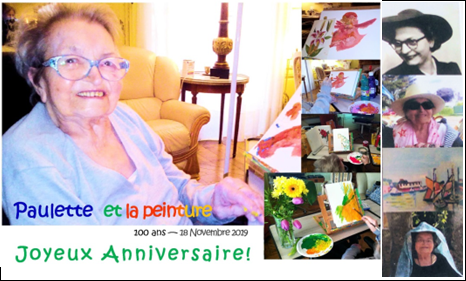 Figure 1: 100 years’ Birthday Anniversary, November 2019.
Figure 1: 100 years’ Birthday Anniversary, November 2019.
Educated and fond of art, Paulette used to draw and paint as an amateur for a long time. She liked to use images – art, postcards, photos – as a source of inspiration and tried to make her best to reproduce what she saw. She succeeded pretty well.
But in the last few years she showed signs of depression as her mental health declined after the loss of her son. She stopped painting, reading, speaking…
When I met her in 2014 aged 95, Paulette presented symptoms of cognitive regression but was still able to walk, to speak, to paint. She was happy to experiment art therapy with me once a week for 1,5 hours at her home, when her general body/mind state allowed it.
In her early art therapy work she mostly expressed pain and sadness (Fig.2).
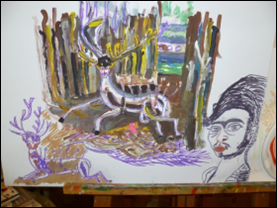 Figure 2: Suffering and depression, identifying to Frida Kahlo – 2014.
Figure 2: Suffering and depression, identifying to Frida Kahlo – 2014.
After several months of art therapy sessions, with painting, drawing as well as visiting art exhibitions, her mood got much better. She realised colorful, humoristic and pleasant art work (Fig.3, gouache and acrylic painting, 2015).
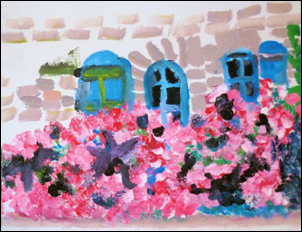 Figure 3: “My house in Brittany”
Figure 3: “My house in Brittany”
Late 2016, Paulette had a stroke. She got hemyplegic, the left side of her body was paralysed and her art work clearly showed the loss of the left-side vision and spacial orientation.
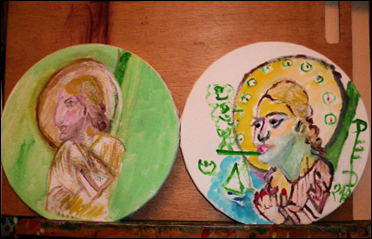 Figure 4: The same model , before (2015) and after (2016) the first brain stroke.
Figure 4: The same model , before (2015) and after (2016) the first brain stroke.
At this time I was more directive about her work in order to progressively restaure her abilities. I insisted on the blank parts of the surface, on turning the canvas upside down or from left to right, discussing it with her, explaining the missing elements of the model. After one year she progressed and was able again to view and use the whole painting surface. She also learned to use again her left hand and walk with a stick. She partially recovered her verbal abilities.
Two years later she had a second brain stroke which left her more invalidated. The same symptoms reappeared and we restarted the process (Fig.5). The recovery was longer and less complete but still painting and drawing made Paulette happy. At my arrival she generally seemed tired and absent but she always recognised me. After some mild stimulation, patient encouragements and sometimes material help she succedeed in creating art pieces which herself appreciated as satisfying (Fig.6).
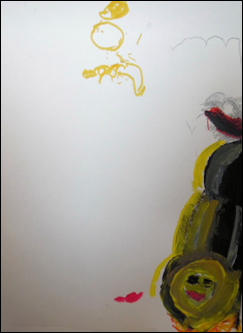 Figure 5: Painting shortly after the second stroke, 2018.
Figure 5: Painting shortly after the second stroke, 2018.
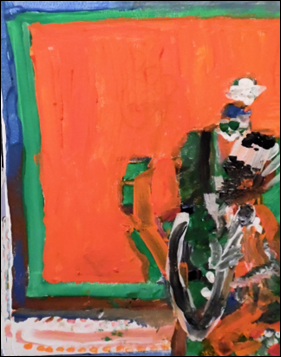 Figure 6: One year after the second stroke, 2019.
Figure 6: One year after the second stroke, 2019.
I was cautious about being excessively insistant, respected her choice to work or not, always asked her about what she thought and what she wished. Did she want a model or not, which kind : a portrait, a landscape, a family photo… ? Sometimes we succeeded in having a five minutes conversation. Her figurative capacities diminished after the second stroke, but she recovered the use of her left hand and the joyfull attitude to art making(Fig.7).
 Figure 7: Recovering after the second stroke, using both hands and the whole surface to paint, 2018-2019.
Figure 7: Recovering after the second stroke, using both hands and the whole surface to paint, 2018-2019.
Unfortunately, the coronavirus pandemic interfered with the art therapy dynamics…Paulette had to lay in bed for the two month of the confinement because of the reduced number of her care helpers. When recently I saw her again, she sat in her wheelchair facing the TV, apathic and sad. I offered her brilliant red peonies as I knew she loved them and thought she will appreciate to paint. I proposed her a few felt-pens…but she had to provide a big effort to concentrate on the flowers…obviously the prolonged lack of stimulation induced depression and regression . Nevertheless after a while Paulette slightly smiled in my direction.
This case shows the efficiency of art therapy with depression, brain stroke, hemiplegia and dementia. In spite of her age and comorbidity, Paulette partially recovered her skills after two strokes and was able to overtake depressive states of mind. An important point is that she had no medication – the art therapy was her single treatment.
I have had the opportunity to find this results in other cases. The recovery is easier for younger persons. Anyway – and for all-ages patients – art therapy is highly recommended in association with body or medical treatments, because of its unique action. The specificity of art therapy is to provide physical/emotional brain effects via art making, to reconnect the patient with his/her inner self, life history and imagination, body and mind, cognition and creativity, as well as with social skills.
Art Therapy is an empathic and perseverent process, a powerfull lever for comprehensive mobilization of psychological and physiological health components of the human individuality.
All the pictures from Fig.2 to Fig.7 are illustrating Paulette’s work in the art therapy sessions. She signed the authorizations for publishing them, as well as for the Fig.1 representing herself and edited for her 100 years’ birthday anniversary. She was very happy to contribute to knowledge about art therapy.
In August 2022, I was informed by the family that Paulette passed away at the age of 103.
- Kim, S. H., Kim, M. Y., Lee, J. H., & Chun, S. (2008). Art Therapy Outcomes in the Rehabilitation Treatment of a Stroke Patient: A Case Report. Art Therapy, Journal of the American Art Therapy Association, 25(3), https://doi.org/10.1080/07421656.2008.10129593
- Kim, M. K., & Kang, S. D. (2013). Effects of Art Therapy Using Color on Purpose in Life in Patients with Stroke and Their Caregivers. Yonsei Med J, 54(1), 15-20. DOI: 10.3349/ymj.2013.54.1.15
- Michaels, D. (2010). A space for linking: Art therapy and stroke rehabilitation. International Journal of Art Therapy, 15(2), 65–74. https://doi.org/10.1080/17454832.2010.523896













